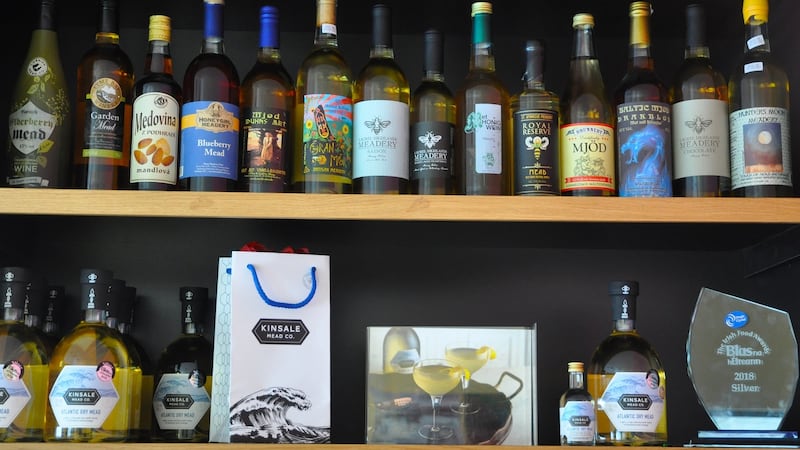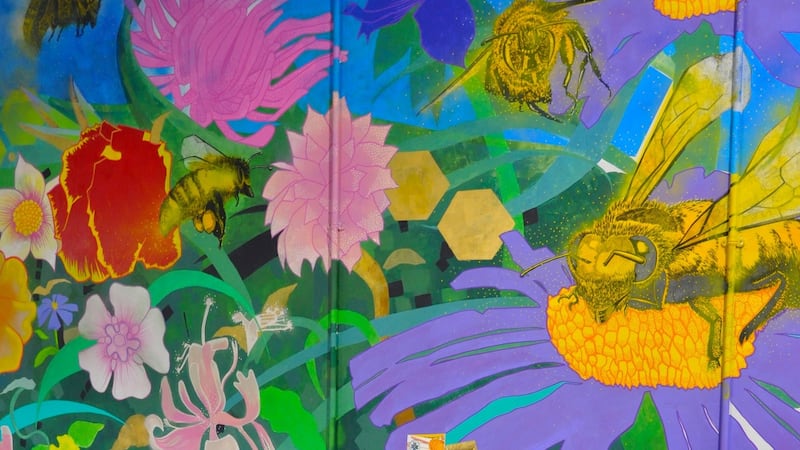Bees are certainly creating a buzz in the world of brewing. The US saw a huge increase in meaderies over the past few years, from just 30 in 2003 to 300 and counting in 2016.
The American Mead Makers Association holds a two-day conference annually in Boulder, Colorado. Each year it draws a larger crowd of mead fans and mazers (mead makers) with the Mazer Cup held on day three. It’s a competition for mead makers to submit their meads and win, with the ultimate aim being that “mead is restored to its rightful place as a mainstream beverage”.
Kinsale Mead, Ireland’s first new meadery in nearly 200 years, has won gold at the Mazer Cup for their Atlantic Dry mead, which gave me the perfect excuse to visit their beautiful meadery and learn all about how they create their multi-award winning drinks.


Mead is the world’s oldest alcoholic drink, made by fermenting honey in water. Also known as the nectar of the gods, honey wine or ambrosia, it immediately conjure up images of battles, goblets and chieftains. Mead was popular with Vikings, Mayans, Egyptians, Greeks and Romans alike. Te’j is a type of bittersweet mead from Ethiopia that can be traced back to the fourth century, and is still made today. Mead was associated with immortality and otherworldly powers, often featuring in Greek ceremonies due to its symbolism and the magic that it represented.
In England, mead was seen as medicinal, with a potent infusion of herbs in the sweet mead. These types of spiced, herbal meads are called metheglin, derived from the Welsh word for medicine. The honey used determined the flavour of the mead. Traditional mead often uses a mild honey such as orange blossom, acacia or clover. Sturdier, spiced meads result from wildflower, blackberry or buckwheat honeys.
Beery blend
Mead comes in dry, sweet, still or sparkling styles. You can also add berries such as raspberries or strawberries to create a melomel. Apple-based meads are referred to as cyser, while braggot is a mead that has been brewed with hops or barley for a beery blend.
Mead has featured in literature from Beowulf to Tolkien’s mead halls at Rohan in The Lord of the Rings. More recently, the drink has played a role in popular television shows such as Game of Thrones and Vikings, and for meaderies such as Kinsale Mead, this has been great for business.
Kate and Denis Dempsey founded Kinsale Mead in 2017. Their meadery is in the heart of Kinsale in Co Cork, and welcomes visitors from all over the world for tours and tastings.
Kate gives me a tour, talking me through each step of the mead-making process, beginning at a big green drum of honey where we taste different honeys. They use Spanish orange blossom honey at Kinsale Mead. There is not enough Irish honey to produce mead on a commercial scale, although they are working on limited edition batches using local honeys.
The orange blossom honey, which is raw and unpasteurised, is sublime. It’s mixed with warm water and pumped slowly into modern stainless steel German fermentation tanks, with essential temperature controls.
Frozen fruit
Stainless steel is safer than wooden barrels at this scale of production, as mead – with its low alcohol level at 12 per cent – risks contamination. For their red mead, frozen fruit in mesh bags is added to the tank, before the warm honey water is poured over. As the fruit defrosts it rises to the top and releases all of it’s precious juice, mixing with the honey water. The temperature is kept at the right range to keep the yeasts happy, and the yeast is fed with nutrients. They use commercial yeast at Kinsale Mead, as wild yeasts can be unpredictable. The first few days are crucial in the ferment so it’s constantly being monitored and tasted.

Next, the mead is degassed to remove the fizz. When it reaches 12 per cent alcohol, the temperature is brought right down and the entire tank is swathed in bubble wrap and the yeast goes dormant. As the yeast “flocculates” – whereby any particles or sediment clumps together and settles to the bottom of the tank, the mead clears. The dead yeast is cleared using a cross flow filter from the Italian wine and cider industry, a slow and careful filtration process which ensures the perfect mead.
Bottling
Then it’s time for bottling. The gorgeous glass mead bottles are shaped like the traditional straw skep beehive, which were used for catching and transporting swarms of bees. An inert gas is added to prevent further fermentation when the mead is bottled, corked and labelled, all done by hand.
Kate learned how to make mead from watching her father’s home brewing when she was little, from talking to other mead makers, and by making mead. There are very active mead groups on Facebook, full of information and tips for the homebrewer. The mead-making community is very supportive of one another. Kate tells me that if you ask seven mead makers a question you are guaranteed to get 10 different answers, with everyone drawing from their own knowledge and experiences.
Next we taste the mead. The Atlantic Dry looks like a light Sauvignon Blanc but has orange blossom honey, floral and citrus notes with a slight touch of almond from what the bees forage. There’s a faint herbal, almost aniseed fennel flavour coming through. It should be served chilled, mixed with a neutral tonic water or on its own over ice. The Atlantic Dry mead is ideal accompanied by toasted almonds, olives or seafood. It’s also great for using in cocktails.
Dark cherries
The Wild Red mead is delicious served at room temperature. It uses Wexford blackcurrants from Jeffares in Wexford, and dark cherries. It is ideal with fatty meats, strong cheese and savoury dishes.
The Hazy Summer mead has strawberries and raspberries on the nose and is lighter at 11 per cent, perfect served chilled with cheesecake as a dessert wine alternative. It’s the result of six different types of berries muddled together with the honey.
It is a natural and sustainable product, made using pure ingredients. The continued interest in all things craft brewing and distilling has brought mead back into the limelight, but it is unlikely to have as massive a surge in popularity as craft gins, according to Susan Boyle from Two Sisters Brewing, simply because honey is far too expensive and there is not enough of it to fuel a mead boom. Susan and her sister Judith do brew a beer that has a special nod to mead; Brigid’s Ale uses their own honey with local barley and water. It’s a rich copper colour with a floral, honeyed nose which is balanced by earthy hops. A beautiful beer to enjoy with hard cheese or honey roast nuts.
www.kinsalemeadco.ie www.twosistersbrewing.com
Mural at Kinsale Mead by local artist Fiona Boniwell




















